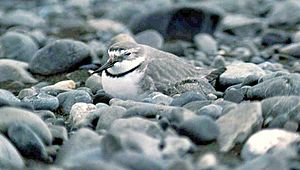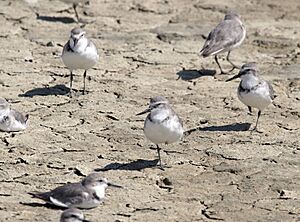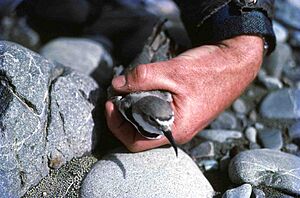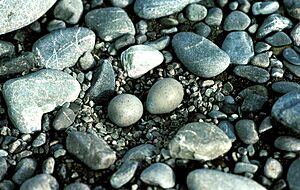Wrybill facts for kids
Quick facts for kids Wrybill |
|
|---|---|
 |
|
| Wrybill sitting on eggs | |
| Conservation status | |
| Scientific classification | |
| Genus: |
Anarhynchus
|
| Species: |
frontalis
|
The wrybill is a special bird found only in New Zealand. Its Māori name is ngutuparore. This bird is unique because its beak is bent sideways, always to the right! No other bird in the world has a beak quite like it.
Scientists have studied the wrybill and found it's related to other New Zealand plovers, like the New Zealand dotterel and the double-banded plover.
Wrybills lay their eggs among rocks in rivers. If someone gets too close, they pretend to be hurt to lead the intruder away from their nest.
This amazing bird is listed as vulnerable by the International Union for Conservation of Nature (IUCN). This means it needs our help to survive.
Contents
About the Wrybill
French scientists Jean René Constant Quoy and Joseph Paul Gaimard first described the wrybill in 1830.
What Does a Wrybill Look Like?
The wrybill is a small, round bird, about 20 to 21 centimeters (8 inches) long. It weighs between 43 and 71 grams (1.5 to 2.5 ounces).
Males and females look a little different. Males have a white forehead, light grey head, back, wings, and tail. Their throat, chest, belly, and bottom are white, with a thin black band across their chest. Females have a thinner chest band, and it's less clear in both sexes when they are not breeding. Males also have a small black line between their white forehead and grey head, which females don't have.
The most special part of the wrybill is its long black beak, which always curves to the right. It's the only bird species with a beak bent to one side!
Wrybill Eggs and Chicks
Wrybill eggs are very light grey with tiny brown spots. This helps them blend in perfectly with the rocks around them. It makes them very hard to see!
Adult wrybills and their chicks are also very good at hiding. When they stand still, they are almost invisible against the riverbed. Chicks are light grey on top with black spots and white underneath.
Wrybill Sounds
The wrybill has different calls:
- A short weet sound when flying or to warn of danger.
- A harsher call for greater danger.
- A chirring sound to challenge other birds or threats.
- Young birds make a high-pitched short peep.

Where Wrybills Live and Travel
The wrybill lives only in New Zealand.
Wrybill Homes
They breed on large, braided rivers in the Canterbury and Otago regions of the South Island. They like wide, open rivers that don't get covered with too many plants. Some of their main breeding rivers are the Waimakariri, Rakaia, Rangitata, Waitaki, and Ashley.
Wrybills used to live on smaller rivers too, but now they only live in about 60% of their old areas.
Wrybill Migration
After breeding, from late December to early February, wrybills leave their river homes. They fly to shallow bays and sheltered coastal areas in the North Island. Some popular spots include the Firth of Thames, Manukau Harbour, Kaipara Harbour, and Tauranga Harbour.
Wrybill Behaviour
Wrybills like to gather in large groups during winter. This is very different from breeding season, when they become very protective of their space. They often stand on one leg and hop away if you get too close.
Wrybills are known for their amazing aerial displays, where they fly together in large flocks. This usually happens just before they migrate south.
Wrybill Reproduction
Wrybills usually stay with the same partner each year and return to the same area to breed. If their partner doesn't come back, the bird will find a new breeding spot.
They strongly protect their nesting areas, which can be quite large, from 1 to 11 hectares (about 2.5 to 27 acres). They like to breed close to where they were born. Many pairs will lay two sets of eggs in one breeding season, especially if the first set was lost to floods or predators.
Nests are shallow scrapes in areas with large stones or sand. A female wrybill usually lays two eggs. Both parents take turns sitting on the eggs, but the female does most of it. The eggs hatch after 30 to 36 days.
When chicks hatch, they are covered in soft, downy feathers, grey-white on top and white underneath. Both parents care for the chicks. The chicks can fly after about 35 days and are then ready to live on their own. Young wrybills start breeding when they are two years old.
Wrybill Life Cycle
Wrybills change their feathers (moult) between December and May. This process starts quickly and then slows down as their longer outer feathers grow.
The earliest young birds start migrating in November. Adult birds follow in January or February after they finish breeding, along with the rest of the young birds.
They migrate back to their breeding sites in the South Island in August.
Currently, there are about 5,000 wrybills, but their numbers are slowly going down.
What Wrybills Eat
Wrybills usually look for food in shallow water channels and around the edges of pools. They eat insect larvae, small water creatures, and sometimes tiny fish.
Their unique bent beak helps them find food. It's tilted to the right at an angle, which scientists think helps them reach insect larvae and small creatures hiding under rocks. However, this hasn't been fully proven yet.
Dangers to Wrybills
Wrybills face more dangers during breeding season when they are most vulnerable.
Predators
Introduced animals like ferrets, stoats, weasels, and hedgehogs are a big threat. These animals were brought to New Zealand by people. Wrybills have adapted to native bird predators like raptors, gulls, and owls, but not to these new mammals.
Wrybill chicks and eggs blend in very well with the riverbed, which helps hide them from predators flying overhead. When the main food for these mammal predators (like rabbits) is scarce, they look for other food and often prey on ground-nesting birds like the wrybill.
Other Threats
- Flooding: Big floods can destroy entire nesting areas, reducing the number of chicks that survive.
- Habitat Loss: Wrybills need open, clear areas of shingle on the riverbed to nest. However, introduced plants like gorse, willow, broom, and lupin spread quickly and take over their habitat.
- Human Disturbance: Vehicles driving along riverbeds can disturb the birds and their nests.
Wrybill Conservation Status
The wrybill is listed as vulnerable on the International Union for Conservation of Nature (IUCN)'s IUCN Red List of Threatened Species. This means it's at high risk of becoming endangered if we don't protect it.
In the 1800s, the wrybill population went down because people collected them for museums due to their unusual bent beak. In 1940, they became a protected species. Since then, their population has grown from about 2,000 birds to around 5,000 today.
See also
 In Spanish: Chorlito de pico tuerto para niños
In Spanish: Chorlito de pico tuerto para niños




